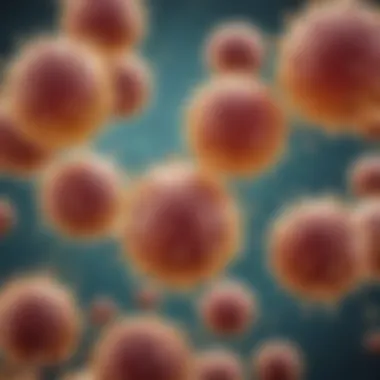Staphylococcal Infections: A Comprehensive Overview


Intro
Staphylococcal infections in human skin pose significant health challenges across various populations. These infections, primarily caused by Staphylococcus aureus, are not only common but can also lead to severe consequences if left untreated. Understanding the nature of these infections is crucial for prevention and management. The insights shared here delve into the prevalence, symptoms, treatment options, and risk factors of staphylococcal infections, aiming to provide a well-rounded perspective for both medical professionals and informed citizens.
Research Context
Background and Rationale
Staphylococcus bacteria are frequent residents of human skin. While many strains are harmless, certain types can cause infections when they penetrate the skin barrier. The prevalence of such infections is particularly high in hospital settings and among individuals with weakened immune systems. This necessitates a thorough exploration of staphylococcal infections to inform better treatment and prevention strategies.
Understanding staphylococcal infections is imperative due to their widespread nature. These organisms present significant public health concerns, especially in the era of increasing antibiotic resistance. As infections become more complicated to treat, awareness and education become paramount.
Literature Review
Various studies have examined staphylococcal infections, highlighting their implications on skin health. Research indicates that Staphylococcus aureus is often found in skin lesions, causing conditions ranging from mild skin rashes to severe systemic infections. Additionally, there is a growing body of literature addressing the emergence of antibiotic-resistant strains, particularly Methicillin-resistant Staphylococcus aureus (MRSA), which complicates treatment strategies. The need for comprehensive insight into these infections is increasingly urgent as we strive to mitigate their impact on public health.
Methodology
Research Design
This article synthesizes existing research on staphylococcal infections. It combines quantitative data with qualitative insights to provide a holistic view of the subject. The focus is on peer-reviewed articles, clinical guidelines, and expert opinions to ensure accuracy and relevance.
Data Collection Methods
Data was collected from a variety of sources, including:
- Clinical studies from reputable medical journals
- Reviews and meta-analyses addressing risk factors and treatment outcomes
- Guidelines from health organizations like the World Health Organization (WHO)
This multifaceted approach allows for a thorough understanding of staphylococcal infections, informing best practices for both prevention and treatment.
Preamble to Staphylococcus and Skin Infections
Understanding the relationship between Staphylococcus and skin infections is critical for grasping broader implications on public health. Staphylococcal infections affect diverse populations, presenting varying degrees of severity. The impact of these infections can range from minor irritations to severe conditions that necessitate clinical intervention. An in-depth exploration of this topic can help healthcare providers and the general population appreciate the importance of early detection and appropriate treatment strategies.
Understanding Staphylococcus
Staphylococcus is a genus of bacteria known for its spherical shape and tendency to form clusters reminiscent of grapes. This bacteria includes several species, some of which are benign while others are pathologically significant. The most notorious species, Staphylococcus aureus, is implicated in numerous skin infections, including boils, abscesses, and even more serious infections such as cellulitis and necrotizing fasciitis. Understanding the characteristics of these bacteria, including their mechanisms of action and resistance patterns, can help in choosing effective treatments and understanding the risks associated with infection.
The Skin as an Ecological Niche
The skin serves as a complex ecological niche for various microorganisms, including Staphylococcus species. Its surface presents a unique environment that can both support the resident flora and provide conditions for pathogenic bacteria to thrive. Factors like moisture, temperature, and the presence of cuts or abrasions can considerably influence bacterial colonization and infection. Furthermore, an individual's immune response plays a crucial role in determining whether these bacteria will cause harm. This makes the skin not just a barrier against infection but also a dynamic platform where intricate interactions take place.
"An understanding of skin ecology is essential when examining the pathophysiology of staphylococcal infections."
With this foundation laid, it becomes evident that a multi-faceted exploration of the topic will yield insights not only into the biology of Staphylococcus but also into effective management strategies for skin infections.
Types of Staphylococcus Relevant to Skin
Understanding the various types of Staphylococcus that affect human skin is vital. Each species has its own characteristics and implications for skin health. This section will detail the most notable types, namely Staphylococcus aureus, Staphylococcus epidermidis, and Staphylococcus saprophyticus. Recognizing these infections contributes to appropriate treatment and management strategies, aiding healthcare providers and patients alike.
Staphylococcus aureus
Staphylococcus aureus is perhaps the most notorious among Staphylococcus species, mainly due to its significant impact on human health. This bacterium can be a benign inhabitant of the skin and nasal passages, but it has the potential to cause a wide range of infections.
One main reason for its importance is its ability to produce various virulence factors. These factors include toxins and enzymes that help the bacterium invade tissues and evade the immune system. For instance, alpha-toxin can create pores in human cell membranes, facilitating tissue damage. This exposure can lead to localized infections such as boils or abscesses, as well as more systemic problems like sepsis. Moreover, the emergence of antibiotic-resistant strains, notably Methicillin-resistant Staphylococcus aureus (MRSA), complicates these infections, making them harder to treat.
Staphylococcus epidermidis
Staphylococcus epidermidis is less recognized but remains crucial to consider. This species is generally regarded as a benign skin commensal. However, it can become pathogenic, especially in individuals with compromised immune systems or those with implanted medical devices. S. epidermidis is particularly adept at forming biofilms, which can lead to persistent infections on foreign body surfaces. For example, it is often implicated in catheter-related infections and prosthetic joint infections. The challenges associated with its detection and treatment arise primarily from its ability to resist multiple antibiotics, necessitating careful management in clinical settings.


Staphylococcus saprophyticus
Staphylococcus saprophyticus is a species that attracts less attention but is clinically significant, particularly in urinary tract infections among young women. This bacterium is usually associated with skin and mucosal membranes but can colonize the urinary tract, leading to cystitis and pyelonephritis. Its ability to effectively adhere to uroepithelial cells plays a role in its pathogenic potential. Knowing the distinctive characteristics of S. saprophyticus aids clinicians in proper diagnosis and treatment, especially differentiating it from other urinary pathogens such as Escherichia coli.
Understanding the differences between these Staphylococcus species can guide effective clinical interventions and better outcomes for patients.
This section provides an overview of important Staphylococcus types relevant to skin health. Recognizing the unique properties and potential risks associated with each species is crucial for preventing and managing infections.
Mechanisms of Infection
The mechanisms by which Staphylococcus species infect human skin hold significant relevance for understanding their pathogenicity. Recognizing these processes informs prevention and treatment strategies, ultimately enhancing patient outcomes. This section will explore how these bacteria penetrate the skin barrier and the factors that enable their survival and proliferation within host tissues.
Entry Points on the Skin
Staphylococcus infections often begin when the bacterium finds entry points in the skin. These entry points can occur in various ways, such as:
- Cuts and Scrapes: Even minor abrasions can serve as gateways for infection. The skin's role as a protective barrier is compromised, allowing bacteria to invade.
- Hair Follicles: Staphylococcus can also enter through hair follicles, leading to conditions such as folliculitis. This often occurs in areas where shaving or friction can irritate the skin.
- Existing Skin Conditions: Conditions like eczema or psoriasis can weaken the skin's integrity, making individuals more susceptible to infections.
The bacterial invasion through these entry points can trigger a host response, leading to inflammation and potential complications.
Virulence Factors
Several virulence factors contribute to the ability of Staphylococcus species to cause skin infections. These factors enhance their capability to colonize and evade the immune system. Notable virulence factors include:
- Adhesion Molecules: These molecules facilitate the adherence of bacteria to skin cells. This sticking power is crucial for colonization and sustained infection.
- Enzymes: Certain enzymes, such as coagulase, allow Staphylococcus aureus to create a protective environment, shielding the bacteria from the immune response.
- Toxins: Some strains produce toxins that damage host tissues, leading to more severe symptoms. An example is alpha-toxin, which can cause cell lysis and inflammation.
Understanding these virulence factors is essential for developing targeted therapies to combat Staphylococcus infections effectively.
Overall, the mechanisms of infection provide crucial insights into how Staphylococcus interacts with the human body. This comprehension is vital for devising effective interventions and improving patient care.
Epidemiology of Staphylococcal Skin Infections
Understanding the epidemiology of staphylococcal skin infections is vital. It highlights the scope and impact of these infections on public health, the healthcare system, and individual patients. Staphylococcal infections, particularly those caused by Staphylococcus aureus, are among the most common skin infections. These infections can range from mild to severe and can pose significant health risks, especially in certain populations.
Epidemiological studies provide insights into the prevalence, transmission dynamics, and risk factors associated with these infections. Gathering data on how often infections occur, where they arise, and to whom can inform prevention efforts and treatment protocols. Public health strategies can be better formulated when a clear understanding of these factors is established.
Prevalence Rates
Staphylococcal skin infections present varying prevalence rates depending on geographic region, demographic factors, and healthcare accessibility. Studies indicate that the overall burden of these infections is significant, often reported as affecting millions of people annually.
- In urban areas, reports suggest that Staphylococcus aureus is responsible for a noticeable percentage of skin and soft tissue infections (SSTIs). The rates of these infections are climbing, particularly among hospital patients, where effective infection control measures are critical.
- The rise in antibiotic resistance among certain strains, especially methicillin-resistant Staphylococcus aureus (MRSA), has also influenced the perceived prevalence. This strain of Staphylococcus modifies treatment approaches and can result in lengthy hospital stays or even serious complications.
Detection rates have been increasing in both community-associated infections and healthcare-associated infections. Understanding the prevalence provides essential information for healthcare providers and policymakers.
High-Risk Populations
Certain groups are at a greater risk for developing staphylococcal skin infections. Recognition of these populations can guide more focused prevention and treatment efforts. High-risk groups include:
- Patients with compromised immune systems: Individuals undergoing chemotherapy or with conditions like HIV have reduced ability to fight infections.
- Diabetic patients: Blood sugar levels that are unstable can lead to skin complications associated with Staphylococcus.
- Athletes and those in crowded conditions: Close physical contact and shared equipment enhance transmission opportunities.
- Hospitalized patients: They are often more vulnerable due to existing health issues and exposure to invasive medical procedures.
By identifying these populations, healthcare professionals can implement targeted intervention strategies and enhance public health campaigns aimed at early identification and treatment of staphylococcal skin infections.
"Knowledge of epidemiological data is essential for devising effective prevention and management strategies for staphylococcal infections."
This section provides a framework for understanding the impact of staphylococcal infections on different segments of the population and emphasizes the need for continuous monitoring and research in this field.
Clinical Presentation of Staph Infections
The clinical presentation of staphylococcal infections is a crucial element in the understanding and recognition of these conditions. Identifying symptoms and manifestations can direct timely intervention and treatment, which is essential for effective management. The presentation ranges from mild symptoms that can be overlooked to severe conditions requiring immediate medical attention. Recognizing these clinical signs is vital for healthcare professionals and the public alike.
Common Symptoms


In cases of staphylococcal infections, common symptoms often include:
- Redness: Infected areas may appear redder than surrounding skin.
- Swelling: Inflammation often leads to visible swelling.
- Pain: Patients frequently report pain or tenderness in the affected regions.
- Pus Formation: Some infections produce pus, leading to the formation of boils or abscesses.
- Fever: Systemic responses such as fever can occur, indicating a more extensive infection.
These symptoms are indicative and warrant further investigation for an accurate diagnosis. A delay in addressing these signs could lead to complications, including the dissemination of infection.
Severe Manifestations
Severe manifestations of staphylococcal infections pose greater risks and require urgent medical evaluation. These may include:
- Necrotizing Fasciitis: This is a rapid and severe soft tissue infection that can lead to tissue death and systemic shock.
- Septicemia: A serious bloodstream infection that may result from untreated localized infections. It can cause widespread organ failure.
- Endocarditis: Involvement of heart valves that can arise from Staphylococcus aureus entering the bloodstream.
- Widespread Skin Infections: Conditions like impetigo or scalded skin syndrome are particularly concerning, particularly in vulnerable populations.
The presence of severe symptoms necessitates immediate assessment and treatment due to the potential for complications and mortality.
"Prompt recognition of symptoms is key to preventing severe outcomes from staphylococcal infections."
Addressing the clinical presentation systematically aids in developing strategies for early intervention. Understanding symptomatology is not just beneficial for healthcare providers but also empowers patients to seek help when necessary.
Diagnostics for Staphylococcal Infections
Diagnostics for staphylococcal infections represent a crucial step in managing these conditions effectively. Given the potential for severe complications, rapid and accurate diagnosis is essential. The symptoms can overlap with other skin infections, making precise identification of the causative organism vital. Timely diagnostics not only guide appropriate treatment strategies but also help in preventing the spread of infection, particularly in communal settings.
Laboratory Tests
Laboratory tests are fundamental in diagnosing staphylococcal skin infections. Various methods exist, each with its advantages. The most common diagnostic tests include:
- Culture and Sensitivity Testing: This is the gold standard for identifying Staphylococcus species. By culturing samples from affected areas, healthcare professionals can determine the specific strain of bacteria and its antibiotic sensitivities. This helps in tailoring treatment to the individual patient's needs.
- Polymerase Chain Reaction (PCR): PCR is a molecular technique that has gained prominence for its speed and sensitivity. It can detect staphylococcal DNA in samples, offering quicker results than traditional cultures. However, it is not widely available in all settings.
- Blood Tests: While not specific for skin infections, blood tests can help assess the overall health of a patient. Elevated white blood cell counts or inflammatory markers may indicate an ongoing infection.
- Rapid Antigen Tests: These tests detect specific staphylococcal antigens in samples and provide results within hours. However, they may not be as reliable as culture methods.
Implementing proper laboratory protocols ensures that the right tests are ordered, enabling effective detection of staphylococcal infections.
Differential Diagnosis
Differential diagnosis is equally important as it distinguishes staphylococcal infections from other skin conditions. Skin infections can often mimic one another, leading to misdiagnosis if not approached carefully. Conditions such as:
- Impetigo: Commonly caused by Staphylococcus aureus, it can be confused with other bacterial infections.
- Folliculitis: This may present similarly but is usually less severe.
- Cellulitis: Often involving deeper tissue layers, it is crucial to note potential systemic involvement.
- Fungal Infections: These can exhibit similar skin manifestations, necessitating laboratory confirmation.
Healthcare providers must consider the patient's history, clinical presentation, and laboratory findings when making a diagnosis. This process not only aids in targeted treatment but also reduces the risk of complications associated with improper diagnosis.
"A misdiagnosed staphylococcal infection can lead to significant healthcare burdens, affecting both patients and the healthcare system."
Understanding the nuances of diagnostics for staphylococcal infections allows for an informed approach. As the landscape of infectious diseases continues to evolve, advancements in diagnostic techniques are essential to maintain effective patient care.
For more detailed information, you can explore resources like Wikipedia and Britannica.
Treatment Strategies
Effective treatment of staphylococcal infections is critical for patient recovery and to prevent complications. The topic of treatment strategies plays a significant role within this article due its implications on both individual health and broader public health outcomes. This section discusses the various approaches, emphasizing antibiotic therapy and alternative treatment methods.
Antibiotic Therapy
Antibiotic therapy is often the first-line approach for treating staphylococcal skin infections. Staphylococcus aureus, especially methicillin-resistant Staphylococcus aureus (MRSA), presents unique challenges due to its resistance to many conventional antibiotics. As a result, proper identification of the strain through diagnostic tests is crucial before initiating treatment. Common antibiotics that are effective include:
- Vancomycin: Often used for serious MRSA infections due to its efficacy against resistant strains.
- Clindamycin: Useful for skin infections that are susceptible, it can also inhibit toxin production.
- Doxycycline: An alternative for mild to moderate MRSA infections, especially in outpatients.
The choice of antibiotic should be guided by sensitivity patterns and the site of infection. Adverse effects, including allergic reactions and gastrointestinal disturbances, should also be considered before prescribing. Thus, patient monitoring is essential during the treatment period. Furthermore, public awareness about antibiotic misuse remains critical to mitigate the issue of antibiotic resistance.
Alternative Treatment Approaches
Alongside conventional antibiotic therapy, several alternative treatment approaches can supplement healing and prevent the recurrence of staphylococcal infections. These strategies can be especially important for individuals with chronic or recurrent infections. Some notable methods include:
- Topical Antiseptics: Such as iodine, honey, or silver sulfadiazine, can promote healing and reduce bacterial load when applied directly to infected wounds.
- Probiotics: The use of probiotics may help restore skin microbiota balance, potentially reducing pathogenic colonization.
- Phototherapy: Light-based therapies, such as blue light therapy, show promise in reducing Staphylococcus aureus bacteria on the skin surface.


Additionally, lifestyle adjustments play a vital role. Maintaining proper hygiene, ensuring wounds are cleaned properly, and avoiding sharing personal items can significantly reduce infection risks.
It is essential to adopt a comprehensive approach combining both conventional and alternative methods to achieve effective management of staphylococcal infections.
In summary, treatment strategies for staphylococcal infections must be multifaceted, focusing on effective antibiotic use while integrating complementary therapies. This creates a holistic plan for patient recovery and helps mitigate the risk of future infections.
Management of Recurrence
The management of recurrence is a critical component in addressing staphylococcal skin infections. These infections, particularly those caused by Staphylococcus aureus, can present numerous challenges if not appropriately managed. Recurrences not only complicate treatment but also affect the overall quality of life for affected individuals, making it imperative to understand strategies that can minimize these occurrences.
It's important to note that recurrent infections may be due to several factors such as incomplete clearance of the original infection, host factors, or environment. Properly managing these elements can lead to better control of staphylococcal infections.
Preventive Measures
Preventive measures play a fundamental role in reducing the risk of recurrence of staphylococcal skin infections. These steps include:
- Hygiene Practices: Regular hand washing with soap and water is vital. Use of alcohol-based hand sanitizers can also help.
- Wound Care: Proper management of cuts and abrasions can prevent bacteria from entering the skin.
- Avoiding Shared Personal Items: Items like towels, razors, or sports equipment should not be shared to minimize exposure.
- Regular Cleaning of Environments: Frequently disinfecting surfaces that are often touched can help reduce bacterial spread, especially in communal settings.
- Clothing and Bedding Hygiene: Regular laundering of clothes and linens may also play a role in preventing reinfection.
Implementing these measures requires a conscious effort but can significantly decrease the incidence of recurrent infections.
Long-Term Managing Strategies
For long-term management of staphylococcal skin infections, a comprehensive approach is vital. This involves:
- Chronic Suppressive Therapy: In some cases, continuous low-dose antibiotic therapy may be necessary to prevent recurrence, particularly for those with frequent infections.
- Regular Screening: Monitoring individual cases and conducting screening in high-risk populations can aid in early detection and treatment of asymptomatic carriers.
- Education on Skin Care: Educating patients on proper skin care and awareness of potential symptoms can lead to early intervention.
- Consulting Healthcare Professionals: Regular consultations with dermatologists or infectious disease specialists may be necessary for tailored management approaches.
"Long-term strategies provide essential frameworks that address both physiological and behavioral aspects of infection management."
Incorporating these long-term strategies within a healthcare framework can alter the trajectory of staphylococcal skin infection management significantly, reducing the burden not only on individuals but also on public health systems.
Implications for Public Health
The implications of staphylococcal infections extend beyond individual cases, deeply affecting public health systems. Understanding these infections can lead to better prevention and management strategies, ultimately reducing their impact on communities.
Staphylococcus and Community Health
Staphylococcus species, especially Staphylococcus aureus, are prevalent in various environments and can spread in community settings. These infections can emerge from crowded living conditions, poor sanitation, and lack of access to healthcare. Awareness of this issue is crucial.
- Identifying Risk Factors: Knowing the environmental and social risk factors helps communities tailor intervention programs. High-density living conditions, for example, can lead to increased transmission.
- Public Education: Community health initiatives should focus on educating the public about hygiene practices, wound care, and the importance of reporting skin infections.
- Monitoring and Surveillance: Implementing surveillance systems can help track the incidence of these infections in communities, allowing for prompt action to contain outbreaks.
Staphylococcal infections can disproportionately affect vulnerable populations. This includes children, the elderly, and those with compromised immune systems. Awareness leads to interventions that can help protect these at-risk groups.
Healthcare-Associated Infections
Healthcare-associated staphylococcal infections represent a significant burden on health services. In hospitals, surgical settings, and long-term care facilities, the risk of these infections is heightened due to invasive procedures and the presence of multi-drug resistant strains.
- Understanding HAIs: Healthcare-associated infections (HAIs) caused by Staphylococcus aureus often result in complications such as pneumonia, bloodstream infections, and surgical site infections.
- Infection Control Practices: Rigorous infection control measures are necessary. This includes hand hygiene, use of personal protective equipment (PPE), and proper sterilization of medical instruments.
- Feedback Loops: Establishing effective feedback loops can help healthcare facilities analyze infection rates and modify practices accordingly. Regular audits and adherence to best practices can mitigate the spread.
- Collaboration Across Stakeholders: It requires a coordinated effort among healthcare professionals, administrators, and public health entities to implement and support effective infection control strategies.
"Effective public health measures can significantly reduce the transmission of Staphylococcus infections and protect community health at large."
Culmination
In summarizing the findings and insights presented in this article, it is essential to underscore the significance of understanding staphylococcal infections, particularly those caused by Staphylococcus aureus, in human skin health. The article emphasized various aspects such as the types of Staphylococcus relevant to skin infections, their mechanisms of infection, and clinical presentations. The implications of staph infections extend beyond individual cases, affecting public health and community well-being. Knowledge regarding the epidemiology and treatment strategies equips professionals and informed individuals alike with skills to combat these infections effectively.
This exploration highlights the importance of maintaining vigilant hygiene practices and recognizing early signs and symptoms. Education on preventive measures is paramount in mitigating the risks associated with staphylococcal infections. Moreover, an understanding of the ecological niche of the skin aids in grasping how these bacteria thrive, adapt, and sometimes lead to severe health issues.
Key Takeaways
- Staphylococcus aureus is the primary pathogen responsible for notable skin infections.
- Virulence factors play an essential role in how these bacteria cause disease.
- Recognizing symptoms early can lead to better treatment outcomes.
- Preventive strategies are crucial in controlling the spread of infections, especially in high-risk populations.
- The connection between skin health and public health cannot be understated, impacting larger healthcare systems.
Future Research Directions
Future investigations into staphylococcal infections should focus on:
- Developing new antibiotics to combat resistant strains of Staphylococcus aureus.
- Exploring the role of the human microbiome in staphylococcal infection prevention.
- Studying the socio-economic factors influencing the prevalence of skin infections.
- Investigating innovative treatment modalities, including bacteriophage therapy and immunomodulators.
- Enhancing public health education to raise awareness and promote preventive measures in communities.
These directions will not only further our understanding of staphylococcal infections but also contribute to more effective management strategies and improved public health outcomes.



